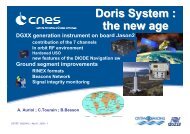IDS activity report 2011 - International DORIS Service
IDS activity report 2011 - International DORIS Service
IDS activity report 2011 - International DORIS Service
Create successful ePaper yourself
Turn your PDF publications into a flip-book with our unique Google optimized e-Paper software.
10.4 FIRST CRYOSAT-2 ANALYSESAt the end of <strong>2011</strong>, 6 ACs (esa, gau, gop, gsc, ign and lca) deliver multi-satellite solutionsincluding Cryosat-2. Cryosat-2, which was launched on April 2010, is the second <strong>DORIS</strong>satellite with the new DGXX <strong>DORIS</strong> receiver onboard (the first one was Jason-2). Theanalyses of these new series shown that adding Cryosat-2 has no major impact on the series interms of transformation parameters (see for example Figure 9).Figure 9. Impact of Cryosat-2 on ESA solutions.Two reasons can explain that Cryosat-2 has no such impact as Jason-2:1. Cryosat-2 altitude (717 km) is lower than Jason-2 (1,336 km) so the 7 channels of the<strong>DORIS</strong> receiver are less used.2. Cryosat-2 orbit inclination (92°) is closer than Jason-2 (66°) to the other 3 <strong>DORIS</strong>satellites (98°) used in the combined solutions.Due to its polar orbit, the major impact of Cryosat-2 should be on the <strong>DORIS</strong> stationspositions located at high latitude. This topic is planned to be studied in 2012 by the <strong>IDS</strong> CC.10.5 COMMUNICATIONSThe <strong>IDS</strong> Combination Center joined both EGU and AGU fall meetings where it presented,respectively, an oral presentation titled “Research activities for continued improvement in the<strong>DORIS</strong> contribution to the reference frame” (Session G2.4), and the poster “Impact of Jason-2and Cryosat-2 on <strong>DORIS</strong> combination” (Session G53A ).43






